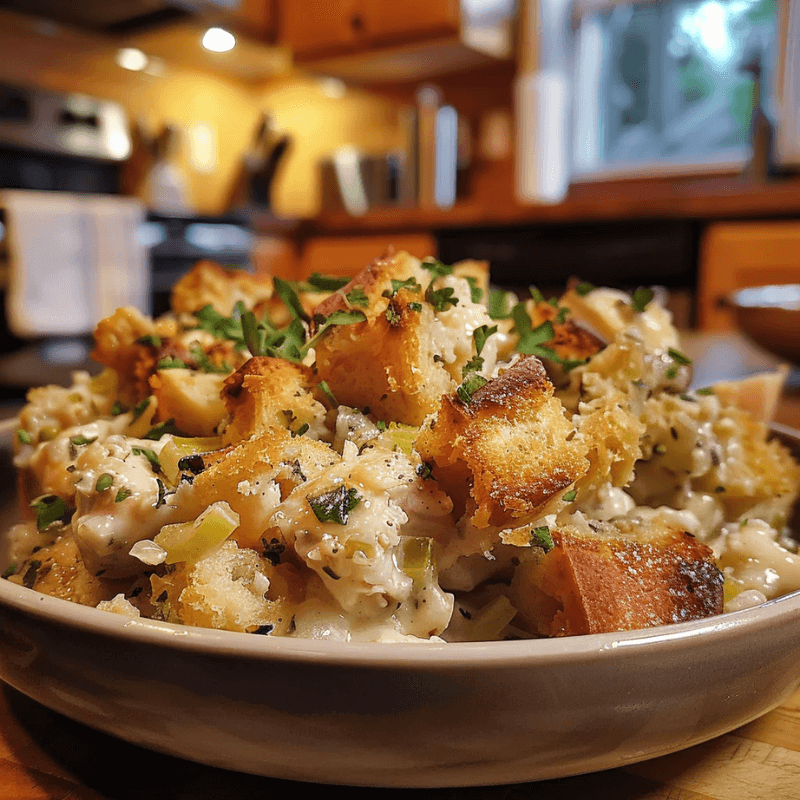Broccoli and cheese risotto combines comfort food appeal with impressive nutritional benefits, delivering 15.1g of protein and 6.1g of fiber per serving. While many assume risotto requires hours in the kitchen, we’ve perfected a chef-approved version that’s ready in just 30 minutes – perfect for busy weeknight dinners.
In fact, this family-friendly recipe serves 4 to 6 people and accommodates multiple dietary restrictions, being gluten-free, nut-free, and soy-free. The secret lies in combining roasted broccoli’s charred depth with sharp cheddar’s rich creaminess, creating what I like to call “risotto mac and cheese” for grown-ups.
I’ll show you the professional techniques behind achieving that perfect creamy texture, selecting the right ingredients, and avoiding common mistakes that can derail your risotto-making success.
The Science Behind Perfect Risotto Texture
The magic of a perfect broccoli and cheese risotto lies in understanding the science behind its luxurious texture. Unlike ordinary rice dishes, risotto’s distinctive creaminess comes from specific starch properties and cooking techniques that transform simple ingredients into something extraordinary.
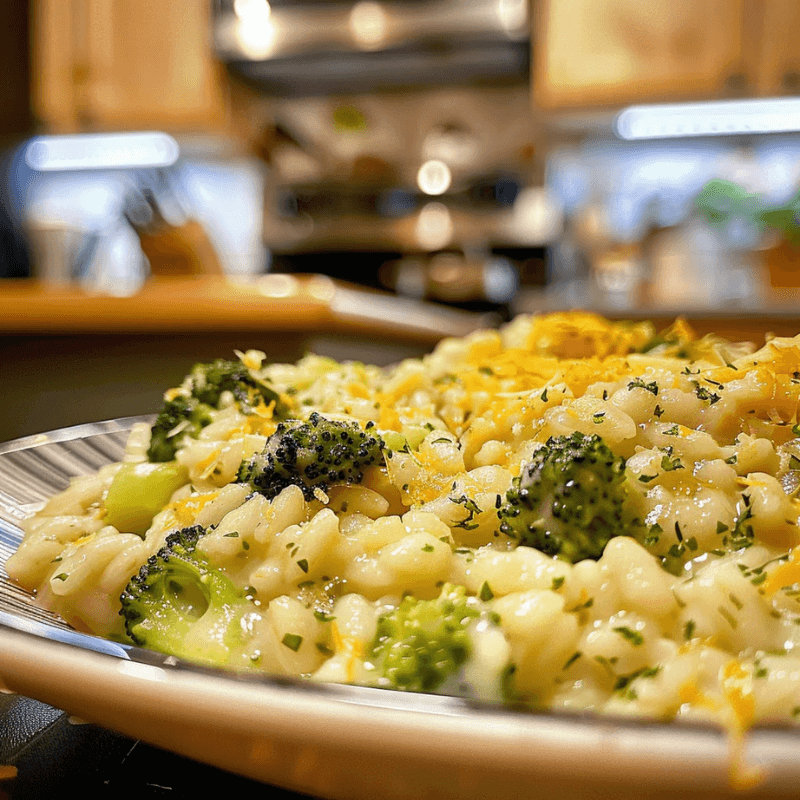
Creamy & Cheesy Broccoli Risotto – So Comforting!
Why arborio rice creates creaminess
Arborio rice isn’t just another grain—it’s a scientific marvel specifically designed for risotto. The secret lies in its unique starch composition, particularly the balance between two molecules: amylose and amylopectin. When making broccoli and cheese risotto, this balance is crucial for achieving that restaurant-quality finish.
Arborio contains a higher proportion of amylopectin compared to most other rice varieties. This specific type of starch gives risotto its signature creaminess without becoming mushy. The rice’s structure features a distinctive core (called “the pearl”) that remains slightly firm when cooked, creating that perfect al dente texture—creamy yet with each grain maintaining its integrity.
What makes Arborio particularly suited for risotto is its minimal milling process, which preserves more surface starch than other varieties. This retained starch serves as the foundation for risotto’s velvety consistency, allowing the broccoli flavors and cheese to blend harmoniously into a cohesive dish.
The starch release process explained
Creating the perfect broccoli and cheese risotto texture depends entirely on proper starch release. Contrary to popular belief, most of the starch that thickens risotto resides on the rice’s surface from the beginning—not from within the grains. This explains why the initial preparation steps are so critical.
The toasting process, where rice is briefly sautéed in butter or oil, creates a protective shell around each grain. This coating serves two essential purposes:
- It allows the grain to absorb moisture slowly without becoming soggy
- It controls starch release, helping grains maintain structural integrity
As you add liquid, the surface starch gradually dissolves into the broth. Each addition of stock, along with gentle stirring, creates friction between the grains. This friction, combined with the slow cooking process, dislodges surface starch particles into the liquid, causing it to thicken progressively.
Additionally, the traditional risotto method requires adding stock in small portions—approximately 4-8 ounces at a time. With each addition, more starch is released into the liquid until it reaches that distinctive creamy consistency that makes broccoli and cheese risotto so irresistible.
Temperature control fundamentals
Maintaining proper temperature throughout the cooking process significantly impacts risotto’s final texture. For broccoli and cheese risotto, temperature management is perhaps the most overlooked yet critical factor in achieving restaurant-quality results.
The ideal temperature for risotto is a medium simmer—not too hot, not too cold. When the heat is too low, the stock takes excessive time to absorb, resulting in unevenly cooked rice. Conversely, excessive heat can break down starch molecules too quickly, reducing their thickening power.
Furthermore, using a wide, shallow pan rather than a deep pot promotes even cooking. In a traditional narrow pot, rice at the bottom (closest to the heat source) often overcooks while the top layer remains undercooked. A wide skillet creates an even layer of rice, ensuring uniform temperature distribution and consistent starch release.
Throughout the 18-25 minute cooking process for Arborio rice, maintaining this steady temperature is essential. When making broccoli and cheese risotto, never let the rice dry out—it should always remain under what Italian chefs call a “veil of broth”, ensuring continuous starch release and absorption for that perfect creamy yet firm texture.
Mastering these scientific principles transforms a simple broccoli and cheese risotto from merely good to memorably exceptional—creating that restaurant-quality texture that keeps everyone coming back for more.
Chef-Approved Ingredients for Superior Flavor
Creating exceptional broccoli and cheese risotto begins with selecting superior ingredients. Quality matters more than technique when crafting a dish with so few components. Indeed, the right ingredients can elevate your risotto from a simple weeknight meal to a restaurant-worthy masterpiece.
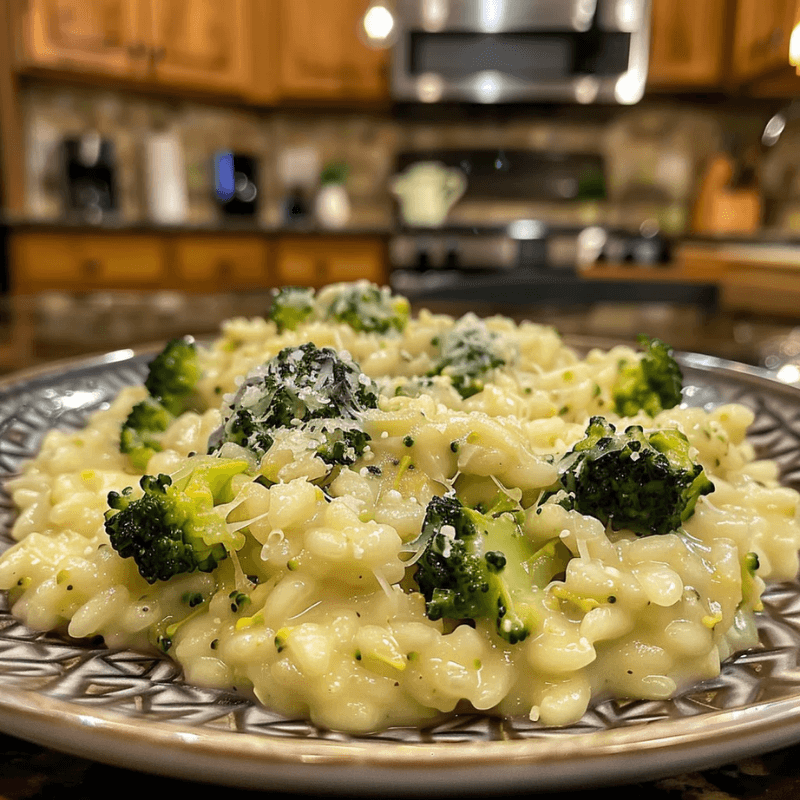
Easy Broccoli and Cheese Risotto – A Perfect Dinner!
Selecting the right rice variety
The foundation of any great risotto starts with choosing the correct rice. Not all rice varieties are created equal when it comes to this classic Italian dish. The ideal risotto rice contains precise starch levels that create that signature creamy texture without becoming mushy.
Among the “superfino” grade (the highest Italian risotto rice classification), these three varieties stand out:
- Carnaroli: Often called the “king” or “caviar” of risotto rice, Carnaroli contains higher starch content than other varieties, producing the creamiest result while maintaining distinct grains. Professional chefs frequently choose this plump, large-grained option for its forgiveness during cooking.
- Arborio: The most widely available risotto rice, Arborio absorbs large amounts of liquid and delivers a hearty texture. Though it contains less starch than Carnaroli, it still creates wonderfully creamy results when handled properly.
- Vialone Nano: This shorter, stubby grain absorbs liquid exceptionally well, making it ideal for softer, “soupy-style” risottos. It cooks faster than Carnaroli and works beautifully with delicate flavors.
Never rinse your risotto rice before cooking—this would wash away the precious surface starch essential for creating that velvety texture.
Choosing the perfect cheese blend
For traditional risotto, Parmesan (Parmigiano-Reggiano) reigns supreme. However, broccoli and cheese risotto specifically benefits from sharp cheddar’s nutty depth. The sharp, distinctive flavor balances beautifully against the mild, creamy rice backdrop.
I’ve found white cheddar works wonderfully, though yellow adds appealing color contrast with the bright green broccoli. For complexity, consider these combinations:
First, a blend of Parmesan with sharp cheddar creates depth without overwhelming the broccoli. Alternatively, a mixture of Asiago (1½ tablespoons) with Parmesan (1 tablespoon) adds sophisticated tanginess. For adventurous palates, combining Jack, Colby, and Swiss cheeses creates a unique flavor profile.
Regardless of your selection, always add cheese after removing the pot from heat to prevent stringy texture or separation.
Broccoli preparation techniques
How you prepare broccoli significantly impacts your risotto’s final texture and flavor. Roasting broccoli before adding it creates charred, crispy edges and deepens flavor—a chef’s secret for elevating this dish.
For texture contrast, consider these preparation methods:
Initially, transform broccoli into “rice-sized” pieces by pulsing florets in a food processor or finely dicing with a knife. This technique allows broccoli to integrate seamlessly throughout the risotto.
Alternatively, keep florets larger (about bite-sized) and add them in stages: stems after 10 minutes of cooking and flowers 5 minutes later. This method preserves the broccoli’s texture while ensuring proper cooking.
If time is limited, even steamed or frozen broccoli works—simply fold it in at the end, letting the residual heat warm it through.
Stock selection and enhancement
Contrary to popular belief, homemade stock isn’t mandatory for exceptional risotto. In fact, many professional chefs prefer using lightly salted water instead of store-bought broths.
Why? Store-bought stocks vary dramatically between brands and can overpower delicate flavors. For a broccoli and cheese risotto where you want the ingredients to shine, a simple solution of 6 cups water with 1 tablespoon kosher salt offers a clean foundation.
Nevertheless, if using stock, keep these principles in mind:
Consequently, lighter broths work better for feature ingredients like broccoli and cheese. Consider making quick vegetable broth from leftover root ends and scraps—simply simmer in water until flavorful.
For added depth without overpowering, try a Parmesan broth by simmering cheese rinds with onion and garlic—this complements the cheese in your final dish perfectly.
Most importantly, whatever liquid you choose must stay warm throughout cooking. Cold additions halt the cooking process, resulting in uneven texture.
Professional Techniques for Cooking Broccoli and Cheese Risotto
Turning top-quality ingredients into flawless broccoli and cheese risotto requires mastering specific cooking techniques. Throughout my years in professional kitchens, I’ve refined these methods to ensure consistent results every time.
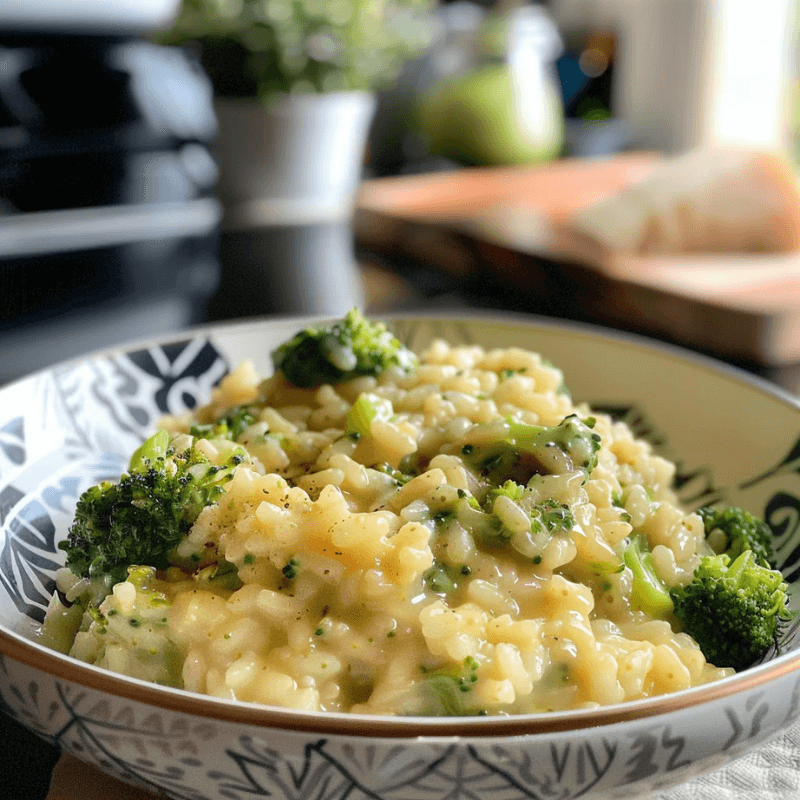
Rich & Flavorful Broccoli Risotto – Made with Love!
The proper toasting method
The foundation of exceptional broccoli and cheese risotto begins with toasting the rice—a process Italians call “tostatura.” This crucial step creates a protective shell around each grain, preventing them from breaking during cooking while developing deeper flavor notes.
Pour your risotto rice into a preheated pan with your soffritto (sautéed aromatics), ensuring each grain gets coated with fat. Toast for exactly 1-2 minutes until the exterior becomes translucent while maintaining a cloudy center—resembling tiny ice cubes. The rice should feel hot to the touch and emit a subtle nutty aroma. Primarily, be vigilant against burning, as this would ruin your entire dish.
Mastering the stirring technique
Contrary to popular belief, constant stirring isn’t necessary—and can actually harm your broccoli and cheese risotto. Chef Antonio Salvatore advises: “Don’t stress about constantly stirring risotto. It’s much better to stir once every 30 seconds and trust the cooking process to do its thing.”
Stirring serves two purposes: preventing rice from sticking to the pan and creating friction between grains to release starch. Excessive stirring introduces too much air, cooling the risotto and creating a gluey texture. Meanwhile, insufficient stirring leads to uneven cooking and potential burning.
Liquid addition timing
For perfect broccoli and cheese risotto, add hot stock gradually—one ladleful (about ¾-1 cup) at a time. After adding, stir briefly, then allow the liquid to be almost fully absorbed before adding more. You’ll know it’s time for more stock by running a wooden spoon across the bottom of the pan—if the path closes slowly, you’re ready for the next addition.
This gradual addition technique, rather than adding all liquid at once, maintains proper temperature throughout cooking and allows controlled starch release. Furthermore, keep your stock hot in a separate pot—cold liquid would disrupt the cooking process.
Achieving the ideal al dente texture
The hallmark of professionally prepared broccoli and cheese risotto is its texture—creamy yet with each grain maintaining integrity and slight resistance. This perfect al dente texture requires precise timing and attention.
Begin testing grains after approximately 10 minutes of cooking. The entire process should take about 16-20 minutes—hardly the arduous process many imagine. The rice should have a discernible bite in its center—firmer than you might expect compared to other rice dishes, yet not crunchy.
Soon after reaching this stage, remove from heat to prevent overcooking, which quickly ruins risotto. Afterward, proceed to the “mantecatura” phase—adding cold butter and cheese—to complete your restaurant-quality broccoli and cheese risotto.
Common Mistakes That Ruin Risotto (And How to Avoid Them)
Even skilled chefs make mistakes when preparing broccoli and cheese risotto. Understanding these potential pitfalls can be the difference between a mediocre dish and restaurant-quality perfection.
Incorrect heat management
Temperature control makes or breaks your broccoli and cheese risotto. The ideal cooking temperature is a medium simmer—about 185 degrees Fahrenheit. Unfortunately, many home cooks commit two opposing errors: cooking too hot or too cold.
When heat is excessive, rice browns unevenly, starch breaks down too quickly, and ingredients stick to the pan bottom. Primarily, this leads to inconsistent texture with some grains mushy while others remain undercooked. Alternatively, heat that’s too low extends cooking time beyond the recommended 18-20 minutes, causing rice to absorb too much liquid and lose its distinctive al dente quality.
For optimal results, maintain a gentle simmer throughout cooking. The surface should bubble slightly without boiling vigorously.
Rushing the process
Risotto demands patience—a virtue many busy cooks lack. Although the entire process typically requires only 18 minutes, attempts to accelerate cooking usually backfire spectacularly.
Common rushing mistakes include:
- Adding cold stock (always keep it warm)
- Pouring in too much liquid at once
- Skipping the crucial toasting step
- Stirring too aggressively
Each shortcut disrupts the gradual starch release process fundamental to proper texture. Despite the temptation to speed things up, risotto simply cannot be hurried. Certainly, it’s better to plan for the full cooking time than to serve a subpar broccoli and cheese risotto.
Poor ingredient quality
The simplicity of broccoli and cheese risotto means each ingredient’s quality becomes magnified. Choosing the wrong rice variety—particularly long-grain or sushi varieties instead of Arborio or Carnaroli—dooms your dish from the start.
Moreover, using low-quality stock dramatically impacts flavor since the rice absorbs it completely. Many chefs recommend homemade stock specifically for risotto, as store-bought versions often contain excessive sodium and artificial flavors that overpower delicate broccoli notes.
Even the cheese quality matters significantly—premium aged cheese melts more smoothly and delivers superior flavor compared to pre-shredded varieties coated with anti-caking agents.
Plating and Presentation Like a Restaurant Chef
After perfecting your broccoli and cheese risotto’s flavor, the final presentation transforms it from home cooking to restaurant-worthy art. Professional plating elevates this humble dish into a memorable dining experience that engages all senses.
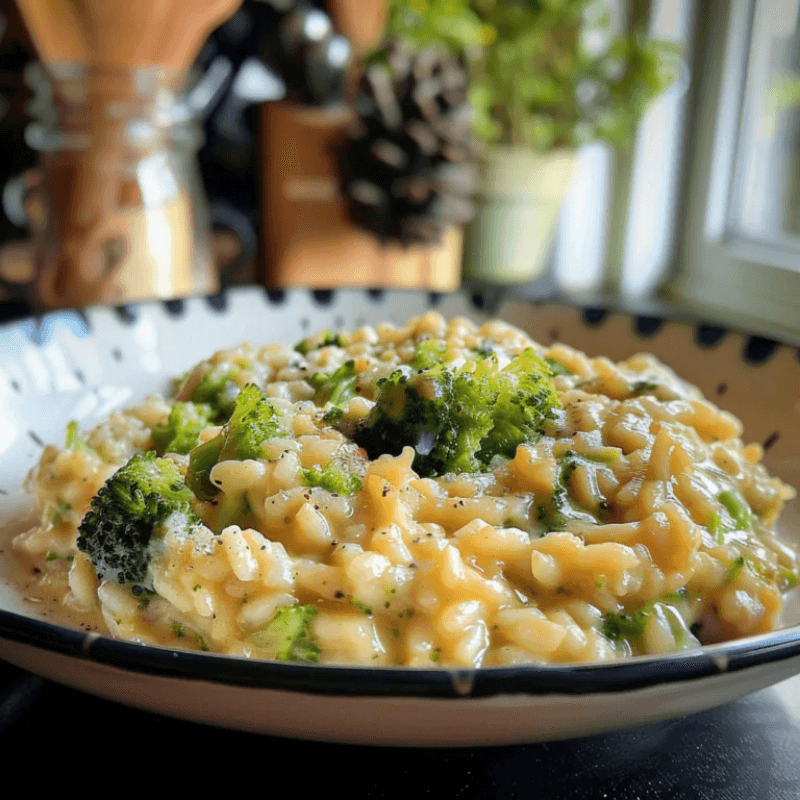
Homemade Broccoli and Cheese Risotto – Silky & Delicious!
Texture considerations
The perfect broccoli and cheese risotto should have proper consistency before plating. When spooned onto a plate, it should spread slightly but still hold its shape. As one chef describes, “If your risotto doesn’t move, it means that you need a little bit more broth”. On the other hand, it shouldn’t run across the plate like soup.
Primarily, restaurant chefs finish risotto with cold butter and cheese off heat, creating that signature luxuriant texture. The dish should “mound on your plate rather than running loosely”. For broccoli and cheese risotto, this final texture ensures the creamy elements properly showcase the vibrant green broccoli pieces.
Garnishing techniques
First thing to remember, garnishes should enhance both flavor and visual appeal. Professional chefs recommend:
- Adding a drizzle of white or black truffle oil just before serving for “rich complex flavors”
- Finishing with shaved Parmesan, cold cubed butter, and fine-cut fresh chives
- Creating contrast with crispy elements like buttery scallops or chicken thighs with crackly skin
For broccoli and cheese risotto specifically, consider a central dollop of crème fraîche which acts as “that extra creamy element” while adding “acid too, which is beautiful in a dish like this”. Sprinkle dried or fresh herbs strategically rather than as an afterthought.
Serving vessel selection
The choice of plate dramatically impacts presentation. Flat plates allow risotto to spread appropriately, whereas deeper vessels contain it more tightly. White plates remain chef favorites as “they make the vibrant colors of the food more visually appealing”, especially beneficial for showcasing broccoli’s bright green against the creamy risotto base.
Equally important, plate size should complement portion size—too large makes portions seem small, too small creates messy overflow. The vessel should enhance your broccoli and cheese risotto’s visual appeal without overwhelming it.
Conclusion
Making restaurant-quality broccoli and cheese risotto requires attention to detail, yet mastering these techniques transforms this classic dish into something extraordinary. Through proper understanding of starch science, careful ingredient selection, and professional cooking methods, anyone can create the perfect creamy texture while maintaining that essential al dente bite.
Remember that patience serves as your greatest ally when preparing risotto. Rather than rushing the process, allow each step its due time – from properly toasting the rice to gradually adding warm stock. This methodical approach, combined with quality ingredients like premium cheese and properly prepared broccoli, ensures consistent success.
Most chefs agree that presentation elevates home cooking to restaurant standards. Thoughtful plating choices, strategic garnishing, and proper texture management create a dish that delights both eyes and palate. After practicing these techniques, you’ll find yourself crafting broccoli and cheese risotto that rivals any professional kitchen’s offering.

Welcome to HealthyBlog365, your go-to destination for all things food and drink. We believe that every meal is not just a way to nourish your body but also a meaningful connection with yourself and your loved ones.
HealthyBlog365 was created with a mission to inspire healthy living through nutritious meals and refreshing beverages. Here, you’ll discover a treasure trove of creative recipes, kitchen tips, and healthy eating trends tailored to fit modern lifestyles.
 What can you find on HealthyBlog365?
What can you find on HealthyBlog365?
- Delicious and easy-to-make recipes: From simple meals for busy mornings to wholesome dinners for family gatherings, we’ve got you covered for every occasion.
- Nutritious drinks: Explore recipes for juices, smoothies, detox teas, and drinks that cleanse your body, boost your mood, and energize your day.
- Guides on eating habits: Get detailed insights into popular diets like keto, low-carb, and vegetarian-friendly meal plans.
- Kitchen hacks: Discover smart tips to save time, preserve food, and cook more efficiently.
We are committed to providing high-quality content, staying up-to-date with the latest trends, and maintaining a balance between nutrition and flavor.
 Connect with HealthyBlog365 on Social Media
Connect with HealthyBlog365 on Social Media
Join the HealthyBlog365 community on social media platforms to stay updated with our latest posts, watch exciting tutorials, and share your food stories with us:
Facebook: Follow us here to stay updated with our latest posts and join our community.
Instagram: Check us out here for inspiring visuals and ideas.
Pinterest: Pin with us here to save creative ideas you’ll love.
YouTube: Subscribe here for detailed tutorials and exciting videos.
 Thank You for Supporting HealthyBlog365!
Thank You for Supporting HealthyBlog365!
We aim to build a connected community where everyone can share and learn from each other. If you have any questions or suggestions, don’t hesitate to reach out to us via social media or our website.
We hope you have a wonderful time on HealthyBlog365 and find new inspiration for your healthy culinary journey!

Broccoli and Cheese Risotto
Description
Ingredients
- 1 cup arborio rice
- 2 cups fresh broccoli florets
- 4 cups vegetable broth
- 1 cup grated Parmesan cheese
- 1 medium onion finely chopped
- 2 cloves garlic minced
- 2 tbsp unsalted butter
- 1 tbsp olive oil
- Juice of 1 lemon
- Freshly cracked black pepper to taste
Instructions
- Prep your ingredients: Gather all ingredients and have your vegetable broth simmering on low heat.
- Sauté aromatics: In a large pot, heat olive oil and butter over medium heat. Add chopped onion; cook until translucent (about 5 minutes). Stir in minced garlic for another minute.
- Toast rice: Add arborio rice, stirring continuously for 2-3 minutes until lightly toasted.
- Gradually add broth: Pour in warmed vegetable broth one ladle at a time, stirring constantly until most liquid is absorbed before adding more.
- Add broccoli: When rice is nearly cooked (about 15 minutes in), add fresh broccoli florets. Stir until rice is creamy and al dente (about 5 more minutes).
- Finish with cheese: Remove from heat, fold in grated Parmesan cheese, lemon juice, and black pepper to taste.

